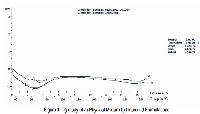Evaluation of Liquisolid Compacts Using Response Surface Methodology
Keywords:
Liquisolid compacts, Carrier, Coating material, HPMC K4M, Response surface methodologyAbstract
Liquisolid Compacts technique has potential to develop sustained release formulations. It involves conversion of liquid drug (either solution or suspension) in non-volatile solvent into free-flowing, non adherent, dry looking and readily compressible powder. In the present work, an attempt was made to develop such formulation of Diltiazem HCl and evaluation using Response surface methodology. Liquisolid compacts were prepared by dissolving Diltiazem HCl in Polyethylene Glycol 400. Then a binary mixture of carrier-coating material, Avicel and Aerosil, was added to liquid medication under continuous mixing in mortar. The HPMC K4M was used as adjuvant for sustaining the drug release. The pre-compression studies for all the formulations were also carried out. The Liquisolid compacts were evaluated in-vitro dissolution studies. Statistical Evaluation: The experimental data was evaluated using Design Expert Software. The % Drug Concentration, ratio of Carrier to Coating material and amount of HPMC K4M are taken as three factors. Response Surface methodology was used to study the influence of the each factor on the response. The present investigation showed that Polyethylene Glycol 400 has important role in release retardation of drug in Liquisolid compacts. The reduction in Tg can be reason for same. The Response surface methodology showed that all the factors were significantly affect the release at 16 hrs.
References
. Jantzen GM, Robinson JR.
Sustained and controlled-release
drug delivery systems. In: Banker
GS, Rhodes CT, editors. Modern
Pharmaceutics. 3rd edition. New
York: Marcel Dekker,1996; pp. 575-
. S. Spireas U.S. Patent 6 (423), 339
B1 (2002).
. Leopold CS, Hentzschel CM,
Alnaief M, Smirnova I, Sakmann A.
Enhancement of griseofulvin
release from liquisolid compacts.
Eur. J. Pharm. Biopharm. 2012;
:130ă135.
. Yadav AV, Shete AS, Dabke AP.
Formulation and Evaluation of
Orodispersible Liquisolid Compacts
of Aceclofenac. Indian J.Pharm.
Educ. Res. 2010; 44 (3): 227-235.
. Elkordy AA, Tiong N. Effects of
liquisolid formulations on dissolution
of Naproxen. Eur. J. Pharm.
Biopharm. 2009; 73: 373ă384.
. Javadzadeh Y, Siahi-Shadbad MR,
Barzegar-Jalali M, Nokhodchi A.
Enhancement of dissolution rate of
Piroxicam using liquisolid compacts.
Farmaco. 2005; 60: 361ă365.
. Spiro Spireas, Srinivas Sadu.
Enhancement of Prednisolone
dissolution properties using
liquisolid compacts. Int. J.
Pharm.1998; 166: 177ă188.
. Javadzadeh Y, Jafari-Navimipour B,
Nokhodchi A. Liquisolid technique
for dissolution rate enhancement of
a high dose water-insoluble drug
(carbamazepine). Int. J. Pharm.
; 341: 26ă34.
. Gubbi S, Jarag R. Liquisolid
Technique for Enhancement of
Dissolution Properties of
Bromhexine Hydrochloride.
Research J. Pharm. and Tech.
; 2 (2): 382-386.
. Nokhodchi A, Javadzadeh Y,
Musaalrezaei Leila. Liquisolid
technique as a new approach to
sustain Propranolol hydrochloride
release from tablet matrices. Int. J.
Pharm. 2008; 362:102ă108.
. Nokhodchi A, Aliakbar R, Desai S,
Javadzadeh Y. Liquisolid compacts:
The effect of cosolvent and HPMC
on theophylline release. Colloids
and Surfaces B: Biointerfaces.
; 79:262ă269.
. Gonjari ID, Karmarkar AB, Hosmani
AH. Evaluation of in vitro dissolution
profile comparison methods of
sustained release Tramadol
Hydrochloride Liquisolid compact
formulation with marketed sustained
release tablets. Digest Journal of
Nanomaterials and Biostructures.
; 4: 651 ă 661.
. Naga Raju. Potnuri G. Rao D,
Ramana G, Rao AS. Design and
evaluation of Diltiazem
hydrochloride matrix tablets by
using gum olibanum. Der
Pharmacia Lettre. 2011;3: 304.
. S. Spireas U.S. Patent 6 (423), 339
B1 (2002).
. Gonjari ID, Karmarkar AB, Hosmani
AH. Evaluation of in vitro dissolution
profile comparison methods of
sustained release Tramadol
Hydrochloride Liquisolid compact
formulation with marketed sustained
release tablets. Digest Journal of
Nanomaterials and Biostructures.
; 4: 651 ă 661.
. S. Spireas U.S. Patent 6 (423), 339
B1 (2002).





